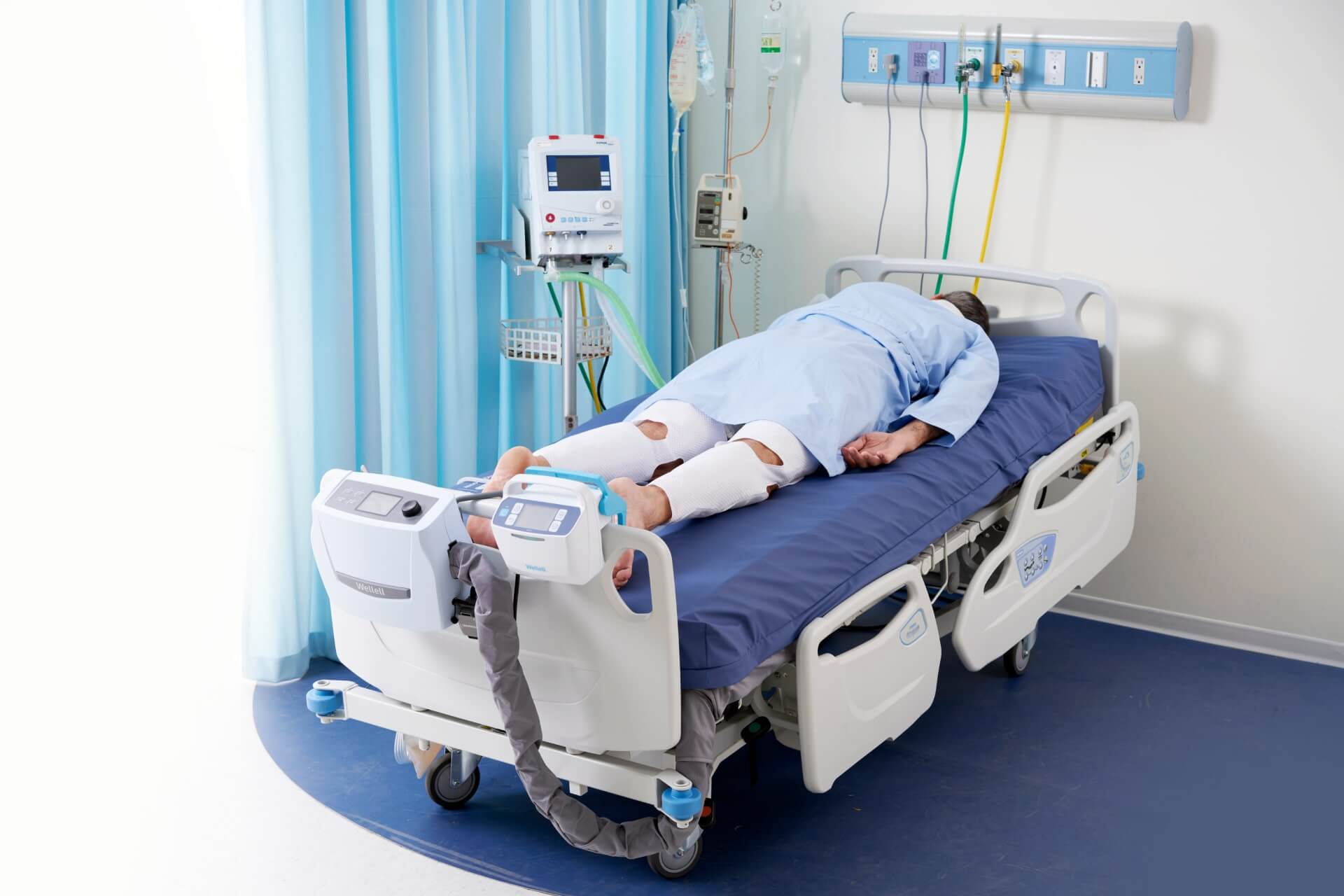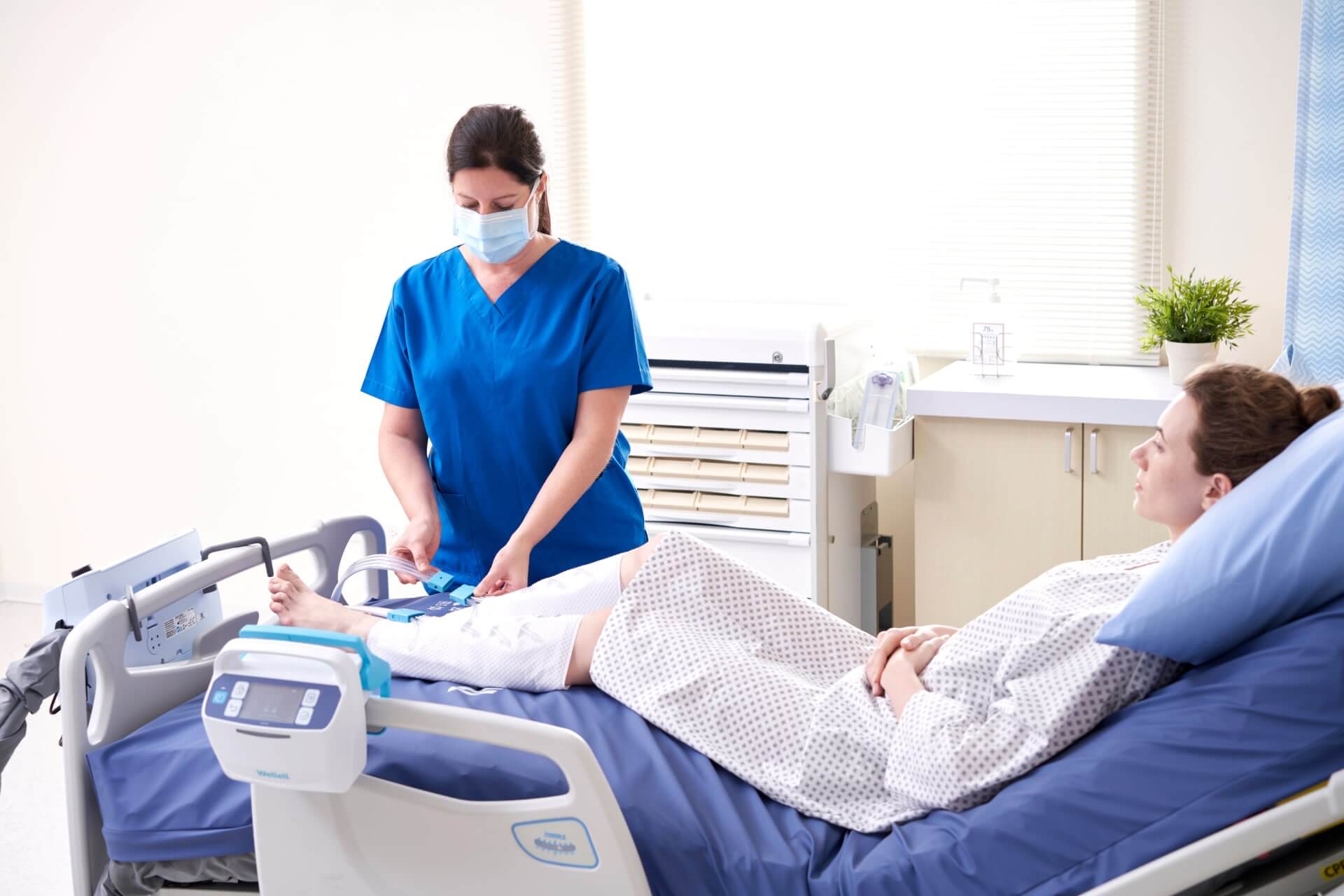VTE Intervention

Venous thromboembolism (VTE) — includes deep vein thrombosis (DVT) and pulmonary embolism (PE) — affects 1 out every 1000 inpatients in the US and is the second leading cause of medical complications resulting in lengthening hospital stays.1,2 Annual VTE-related deaths for the USA estimates at 296,000 and 370,000 for Europe.3
With an annual cost of USD 27.2 billion on treating initial hospital-acquired VTE events (52% as hospital-acquired preventable costs) and another USD 34.4 billion for hospital-acquired VTE reoccurrence treatments (56% as hospital-acquired preventable costs), VTE-related hospital expenses impose a heavy burden on healthcare systems.4
Compression therapy pressure and frequency delivery automation, ambient-regulating compression garments for different body regions, and intuitive interfaces and commands for easy treatment management, tracking, and monitoring simplify healthcare providers' workflow, improving patient comfort, complication prevention, and outcomes.

1 out of every 1000 inpatients develop DVT every year (US)
American College of Chest Physicians® recommends mechanical VTE intervention for hospitalized acutely and critically ill inpatients at a high risk of major bleeding. Effective VTE interventions significantly reduce costs, risk of reoccurrences, morbidity, and mortality.7

DVT complications increase length of stay by 9 days.
20% to 50% of patients with proximal DVT develop post-thrombotic syndrome (PTS), and 5% to 10% progress into severe cases such as venous ulcers,8 which increases the length of stay by 9 days and inpatient cost to over USD 103,860, on top of existing hospital expenses.9
Reference
- Heit JA. Epidemiology of venous thromboembolism. Nat Rev Cardiol. 2015 Aug;12(8):464-74. doi: 10.1038/nrcardio.2015.83. Epub 2015 Jun 16. PMID: 26076949; PMCID: PMC4624298.
- Geerts WH, Bergqvist D, Pineo GF, Heit JA, Samama CM, Lassen MR, Colwell CW. Prevention of venous thromboembolism: American College of Chest Physicians Evidence-Based Clinical Practice Guidelines (8th Edition). Chest. 2008 Jun;133(6 Suppl):381S-453S. doi: 10.1378/chest.08-0656. PMID: 18574271.
- Lin J, Lingohr-Smith M, Kwong WJ. Incremental health care resource utilization and economic burden of venous thromboembolism recurrence from a U.S. payer perspective. J Manag Care Pharm. 2014 Feb;20(2):174-86. doi: 10.18553/jmcp.2014.20.2.174. PMID: 24456319.
- Mahan CE, Borrego ME, Woersching AL, Federici R, Downey R, Tiongson J, Bieniarz MC, Cavanaugh BJ, Spyropoulos AC. Venous thromboembolism: annualised United States models for total, hospital-acquired and preventable costs utilising long-term attack rates. Thromb Haemost. 2012 Aug;108(2):291-302. doi: 10.1160/TH12-03-0162. Epub 2012 Jun 28. PMID: 22739656.
- Lindblad B, Sternby NH, Bergqvist D. Incidence of venous thromboembolism verified by necropsy over 30 years. BMJ. 1991 Mar 23;302(6778):709-11. doi: 10.1136/bmj.302.6778.709. PMID: 2021744; PMCID: PMC1669118.
- Grant JD, Stevens SM, Woller SC, Lee EW, Kee ST, Liu DM, Lohan DG, Elliott CG. Diagnosis and management of upper extremity deep-vein thrombosis in adults. Thromb Haemost. 2012 Dec;108(6):1097-108. doi: 10.1160/TH12-05-0352. Epub 2012 Oct 23. PMID: 23093319.
- Guyatt GH, Akl EA, Crowther M, Gutterman DD, Schuünemann HJ; American College of Chest Physicians Antithrombotic Therapy and Prevention of Thrombosis Panel. Executive summary: Antithrombotic Therapy and Prevention of Thrombosis, 9th ed: American College of Chest Physicians Evidence-Based Clinical Practice Guidelines. Chest. 2012 Feb;141(2 Suppl):7S-47S. doi: 10.1378/chest.1412S3. Erratum in: Chest. 2012 Apr;141(4):1129. Dosage error in article text. Erratum in: Chest. 2012 Dec;142(6):1698. Dosage error in article text. PMID: 22315257; PMCID: PMC3278060.
- Kahn SR. The post-thrombotic syndrome. Hematology Am Soc Hematol Educ Program. 2016 Dec 2;2016(1):413-418. doi: 10.1182/asheducation-2016.1.413. PMID: 27913509; PMCID: PMC6142466.
- Trivedi NN, Abola MV, Kim CY, Sivasundaram L, Smith EJ, Ochenjele G. The Incremental Cost of Inpatient Venous Thromboembolism After Hip Fracture Surgery. J Orthop Trauma. 2020 Apr;34(4):169-173. doi: 10.1097/BOT.0000000000001675. PMID: 31977669.
